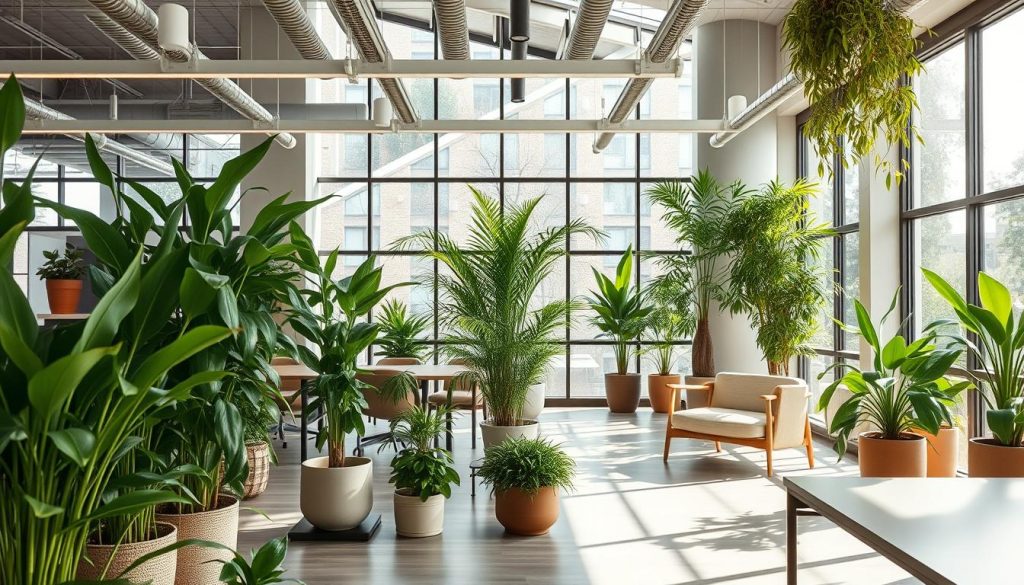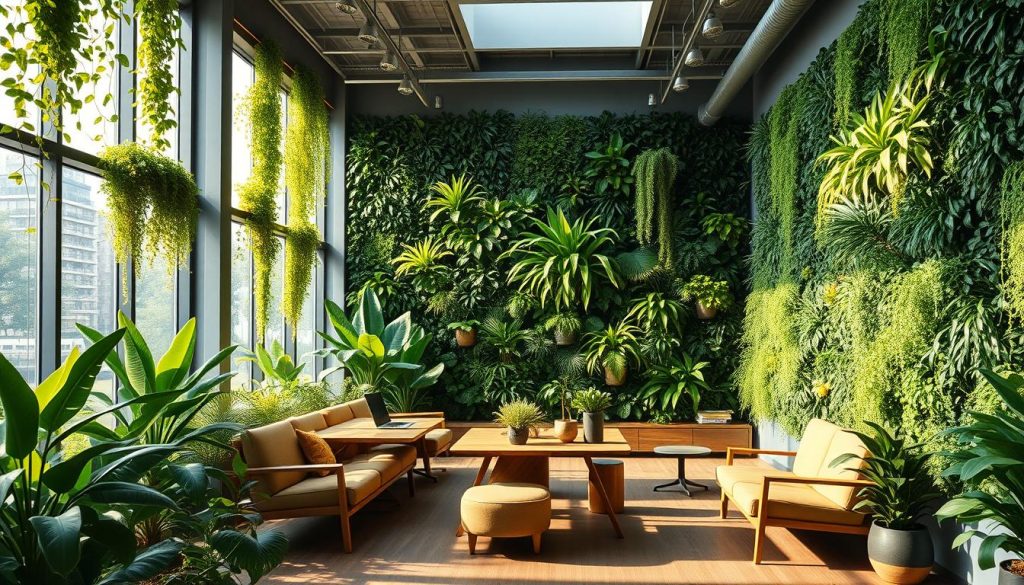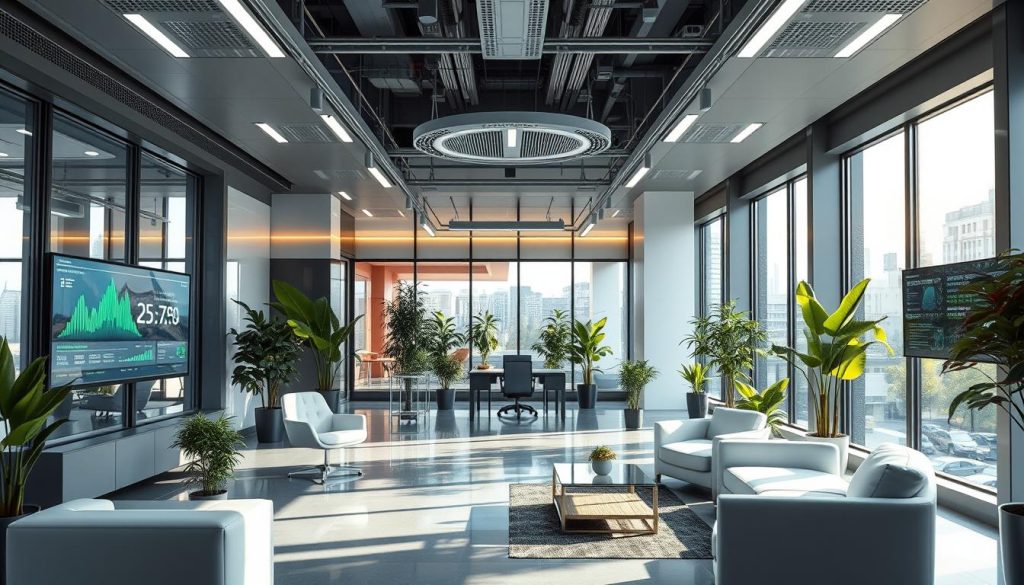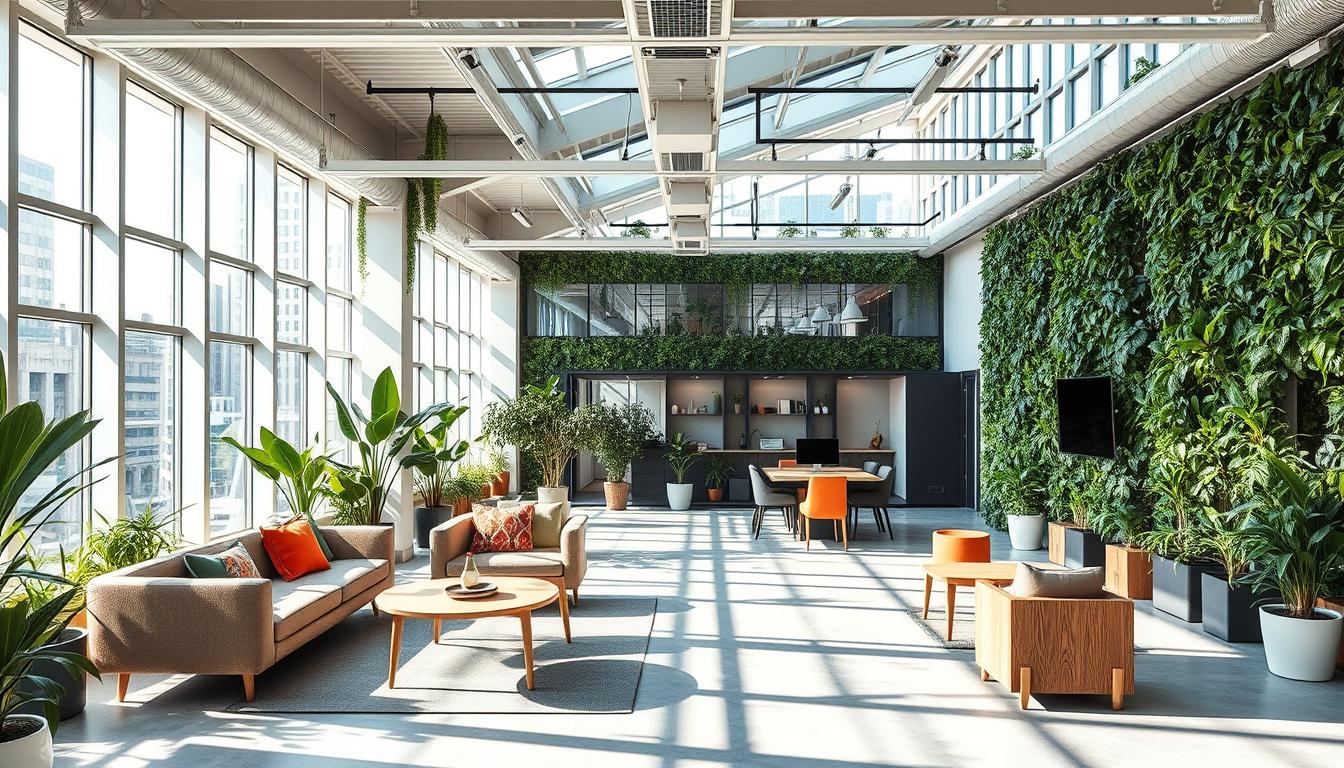I’ve seen a big change in office design lately. Eco-friendly workspaces are becoming more common. They’re good for the planet and also help businesses grow.
Sustainable office design is not just a trend. It’s a smart choice that benefits everyone. Green offices cut down on energy costs and make employees happier. I’m excited to share how these spaces are changing our work places.
In this article, we’ll explore green offices. We’ll talk about why they matter, how they’re made, and their effects. Whether you run a business or work for one, there’s something here for you. Let’s learn how to make our workplaces better and greener together.
The Rise of Sustainable Office Design
Sustainable office design is becoming more popular in the United States. I’ve seen a change towards interiors that are good for the planet and look great. This change is changing how we view our workspaces.
Green offices are making a big difference for our environment. They use less energy, create fewer emissions, and help save natural resources. More businesses are adopting eco-friendly practices, like using recycled materials and energy-efficient systems.
Economic Advantages for Businesses
Sustainable office design is good for the planet and the wallet. Companies save on energy bills and maintenance. Green buildings also have higher property values. Many businesses see a quick return on their investment in eco-friendly interiors.
Employee Well-being and Productivity
Employees in green offices feel happier and healthier. They’re more productive and take fewer sick days. Natural light, better air quality, and biophilic elements greatly improve the work experience.
| Benefit | Traditional Office | Sustainable Office |
|---|---|---|
| Energy Costs | High | Low |
| Employee Satisfaction | Moderate | High |
| Environmental Impact | Significant | Minimal |
I expect to see more creative sustainable office designs in the future. It’s clear that this trend will continue, benefiting businesses, employees, and the planet.
Key Elements of Eco-Friendly Workspaces
I’ve seen how eco-friendly workspaces are changing offices today. These green offices focus on being sustainable and good for employees.
Sustainable materials are at the heart of these spaces. Think recycled wood floors and paints that don’t harm the air. Plus, smart systems for energy and lighting help save the planet and money.
Biophilic design brings nature inside, making air better and work more productive. You’ll find living walls, plants, and lots of natural light in these offices.
| Element | Benefits | Examples |
|---|---|---|
| Sustainable Materials | Less harm to the environment, better air | Bamboo desks, recycled fabric chairs |
| Energy-Efficient Systems | Less energy use, saves money | Smart thermostats, solar panels |
| Biophilic Design | Healthier, more productive | Green walls, natural light |
| Waste Reduction | Less waste, saves resources | Recycling stations, digital documents |
Reducing waste is key in eco-friendly offices. Going paperless and recycling a lot cuts down on waste. These steps help offices be green and profitable.
Energy-Efficient Lighting Solutions
In my experience designing energy-efficient workspaces, lighting is key. Smart lighting solutions cut energy use and boost comfort and productivity. This makes offices more sustainable.
LED Technology and Smart Controls
LED lights are a big step forward for energy-saving offices. They use 75% less energy than old bulbs and last longer. Pairing LEDs with smart controls that adjust brightness saves up to 90% on lighting costs.
Maximizing Natural Light
Natural light is free and improves mood and work. I design offices to get as much daylight as possible. Big windows, skylights, and light shelves spread sunlight, cutting down on artificial light needs.
Motion Sensors and Timers
Motion sensors and timers are vital for green offices. They turn lights on only when someone is there. Installing these in places like restrooms and storage can save up to 30% of energy.
| Lighting Solution | Energy Savings | Additional Benefits |
|---|---|---|
| LED Technology | Up to 75% | Longer lifespan, reduced maintenance |
| Natural Light Maximization | Varies | Improved employee well-being, reduced eye strain |
| Motion Sensors and Timers | Up to 30% | Automated control, reduced waste |
Sustainable Materials for Office Furniture
I’m excited to share how sustainable office design is changing our workspaces. Choosing the right materials for office furniture is key. Let’s look at some eco-friendly options that are both stylish and good for the planet.
Recycled materials are a big deal in sustainable office design. I’ve seen desks made from reclaimed wood that add warmth and character. These desks save trees and share a unique story.
Chairs made from recycled plastic bottles are also popular. They’re comfy, last long, and help keep plastic out of oceans.
Using responsibly sourced materials is also important. Bamboo grows fast and needs little resources. It’s great for modern, eco-friendly furniture. Cork is another option that’s renewable and adds natural texture.
Storage solutions are getting creative with upcycled materials. Old shipping containers become stylish filing cabinets. Discarded metal turns into industrial-chic shelving. These pieces reduce waste and add flair to decor.
By picking sustainable materials, we’re making beautiful spaces and helping the planet. We’re investing in a healthier future for everyone.
Implementing Waste Reduction Strategies
I’m excited to share some effective waste reduction strategies for creating zero-waste offices. These green office solutions can significantly reduce environmental impact and cut costs.
Paperless Office Initiatives
Going paperless is a key step towards zero-waste offices. I’ve seen great results from digitizing documents, using cloud storage, and implementing electronic signature systems. These changes not only save trees but also streamline office processes.
Recycling and Composting Programs
Setting up comprehensive recycling stations is crucial. I recommend clearly labeled bins for paper, plastic, glass, and electronics. Composting food waste from the office kitchen can drastically reduce landfill contributions. Many green office solutions now include compact composting systems designed for workspaces.
Reusable Office Supplies
Switching to reusable office supplies is a simple yet effective strategy. I’ve found that providing refillable pens, rechargeable batteries, and cloth towels instead of paper can make a big difference. Encouraging employees to use reusable water bottles and coffee mugs also helps minimize single-use plastic waste.
| Waste Reduction Strategy | Benefits |
|---|---|
| Paperless Initiatives | Reduces paper waste, improves efficiency |
| Recycling Programs | Decreases landfill waste, promotes resource conservation |
| Reusable Supplies | Minimizes single-use items, cuts purchasing costs |
By implementing these strategies, I’ve seen offices transform into eco-friendly spaces that inspire employees and impress clients. The journey to zero-waste offices is ongoing, but these steps provide a solid foundation for sustainable workplaces.
Water Conservation Techniques in the Workplace

In my work on eco-friendly offices, saving water is key. Smart water-saving steps help the planet and save money too.
Installing water-saving devices is a smart move. Low-flow faucets and dual-flush toilets cut down water use. They work well and save water.
Rainwater harvesting is another cool idea. It collects rainwater for things like watering plants and flushing toilets. This cuts down on the need for city water.
Greywater recycling is a big help too. Offices can use water from sinks and showers for plants or toilets. It saves water and cuts down on waste.
| Water Conservation Technique | Potential Water Savings | Implementation Cost |
|---|---|---|
| Water-efficient fixtures | 20-30% | Low to Medium |
| Rainwater harvesting | 30-50% | Medium to High |
| Greywater recycling | 40-60% | Medium to High |
Using these water-saving methods, I’ve made offices more sustainable. They use resources wisely and care for the environment. These efforts also encourage employees to save water at home.
Eco-Friendly Workspaces: Creating a Green Office Culture
Creating eco-friendly workspaces is more than just using sustainable practices. It’s about building a culture that cares for the environment. I’ve seen how a green office culture changes how people think and act, both at work and at home.
Getting employees involved in sustainability is crucial. When they feel part of the effort, they’re more likely to contribute and act. Some effective strategies include:
- Green teams: Groups of employees who lead eco-initiatives
- Sustainability challenges: Friendly competitions to reduce waste or energy use
- Regular workshops: Sessions on topics like recycling and energy conservation
Leadership is key in promoting eco-friendly workspaces. When leaders show they care, it inspires others. Simple actions like using reusable water bottles or joining sustainability events make a big difference.
Training programs are vital for teaching employees about environmental practices. They should learn about recycling, saving energy, and the company’s sustainability goals. Hands-on training sessions are especially effective in making these concepts stick.
| Green Culture Initiative | Employee Participation Rate | Environmental Impact |
|---|---|---|
| Paperless Office Campaign | 85% | 30% reduction in paper use |
| Bike-to-Work Program | 40% | 15% decrease in carbon emissions |
| Office Plant Adoption | 70% | 10% improvement in air quality |
By building a green office culture, companies can make workspaces that are good for the environment and their employees. It’s a win-win situation that every organization should aim for.
Biophilic Design: Bringing Nature Indoors

Biophilic office spaces are revolutionizing sustainable office design. I’ve seen how adding nature to workplaces boosts employee health and productivity. Let’s dive into the key elements of this innovative approach.
Living Walls and Indoor Plants
Living walls are a stunning feature in biophilic offices. These vertical gardens clean the air and add a natural touch. I suggest adding various indoor plants across the office.
From desk succulents to large potted trees, plants calm the atmosphere and lower stress.
Natural Materials and Textures
Sustainable offices often use natural materials like wood, stone, and bamboo. These elements warm up the workspace, making it more welcoming. Using reclaimed wood for furniture or exposed brick walls adds character and supports eco-friendly practices.
Views and Connection to the Outdoors
Maximizing natural light and outdoor views is key in biophilic design. Large windows or glass walls connect indoors to outdoors, making employees feel closer to nature. If views are limited, consider nature-inspired artwork or skylights to bring in more light.
By using these biophilic design principles, we can make workspaces sustainable. They also boost creativity, productivity, and overall well-being.
LEED Certification: Setting the Standard for Green Offices
LEED certification is key in sustainable office design. It’s the top mark for green buildings, leading the way in eco-friendly workspaces. LEED stands for Leadership in Energy and Environmental Design. It rates a building’s environmental performance and promotes sustainable design.
LEED-certified offices are gaining popularity as companies see the benefits of being green. These offices use less energy, reduce waste, and improve air quality. The certification looks at many aspects of a building, such as:
- Energy efficiency
- Water conservation
- Indoor air quality
- Use of sustainable materials
- Location and transportation
Getting LEED certification is more than just being green. It can save a lot of money by using less energy and water. Plus, it attracts the best employees who care about the planet.
As office design gets greener, LEED certification stays important. It encourages companies to keep innovating in eco-friendly workspaces. Whether you’re updating an office or building a new one, LEED certification ensures your space is top-notch in sustainability.
Smart Building Technology for Energy Management

I’m excited to explore how smart building technology is changing energy management in workspaces. These innovations help make workplaces more energy-efficient and better for the environment.
Building automation systems are at the core of smart energy management. They control lighting, heating, cooling, and ventilation using real-time data. For example, occupancy sensors adjust temperature and lighting in unused areas. This saves energy without making the space uncomfortable.
IoT devices are key in making workspaces energy-efficient. Smart thermostats, connected lighting, and power meters work together to use energy better. These devices collect data on how much energy is used, helping facility managers make smart choices.
Data analytics tools are the brains of smart building technology. They analyze the data from IoT devices to find ways to save energy. This approach helps businesses keep improving their energy use, making workplaces more sustainable.
| Technology | Energy Savings | Implementation Cost |
|---|---|---|
| Building Automation Systems | 20-30% | $$$ |
| IoT Devices | 15-25% | $$ |
| Data Analytics Tools | 10-20% | $ |
By using these smart technologies, businesses can make workspaces that save energy and money. The cost of smart building technology is worth it for the long-term savings and better efficiency.
Green Transportation Options for Employees
I’m excited to share how climate-positive workspaces are changing employee commutes. Companies are now offering eco-friendly transport options. This is a big step towards making workplaces more sustainable.
Bike Storage and Shower Facilities
Many offices now have secure bike storage and shower facilities. This encourages cycling to work. It cuts down on carbon emissions and boosts health.
I’ve seen how these amenities can change a workplace. They make it more vibrant and green.
Electric Vehicle Charging Stations
Electric vehicle (EV) charging stations are popping up in parking lots. They support employees who drive electric cars. This leads to cleaner air and less use of fossil fuels.
It’s amazing how this simple addition can have a big impact.
Carpooling and Public Transit Incentives
Many workplaces offer incentives for carpooling and public transit. This might include special parking for carpools or cheaper passes. These programs reduce traffic and build community among coworkers.
